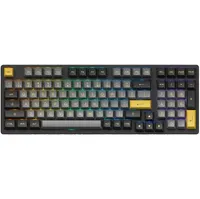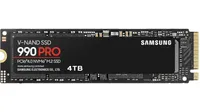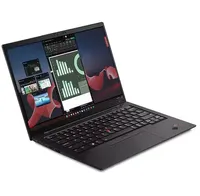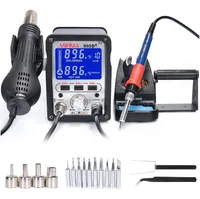I’ve been reviewing tech for 15 years. If you buy me these crappy gadgets, include a gift receipt.
There are far-better alternatives to these cringe-worthy gifts.

As I tell my kids, with gifts, it’s the thought that counts. However, if you buy someone a trash present, you’re demonstrating how little thought you put into it. Know your giftee and don’t give them something that insults their intelligence. You wouldn’t buy a fashionista some knock-off brand clothes or fetid perfume and expect them to like it. Don’t buy a tech geek like me a craptastic gadget or piece of computer hardware.
I’ve been building computers since George H.W. Bush was president and reviewing all kinds of gear, from laptops to phones to USB hubs, since George W. Bush’s second term. I've been reviewing computers professionally for more than 15 years, covering everything from gaming notebooks to SSDs. So, if you’re going to buy me a tech gift that I’ll actually like and use, you have to do your homework and not just jump at the first Black Friday deal you see.
For the love of Jobs and all that’s holy, don’t get me or the tech geeks in your life any of these. And, if for some reason you feel compelled to do so, include a return receipt so we can get your money back and put it toward something useful.
A Membrane (Non-Mechanical) Keyboard
An artist needs their tools and that’s why it’s so important to have an awesome keyboard that helps you type faster and with greater comfort. That means buying a mechanical keyboard with high-quality switches that are either clicky, linear (go smoothly down) or tactile (have a bump feel but quieter). I’m very particular about my keyboards and I must have Kailh Box White clicky switches and some nicely sculpted keycaps to feel comfortable.
So, it’s totally thoughtless to get me or anyone else a non-mechanical (aka membrane) keyboard. These cheaply-made keyboards don’t have physical switches but instead, chintzy rubber domes or other light pieces that make contact with a PCB. It’s like ramming my fingers into one of those bubble poppers that my kids play with 500 times a minute.
Rather than packing a return receipt in the box with this, include a gift certificate to an orthopedist I can see for finger stiffness. Or maybe pack in a claw hammer I can use to put the awful membrane keyboard out of its misery.
Membrane keyboards are often cheaper than mechanical ones, but not always. Here are a couple of affordable mechanical keyboards.
Read moreRead less▼
FL ESPORTS FL980: now $49 at Amazon (was $99)
This affordable, full sized keyboard has Kailh Box white switches along oil-resistant keycaps and sound-deadening silicone that limits rattling.
Read moreRead less▼
Redragon Wired Mechanical Gaming Keyboard: now $35 at Amazon (was $45)
This wired mechanical keyboard features a full layout with a numpad, a white, orange and black color scheme and red, linear switches.
Read moreRead less▼
Akko 3098B Mechanical Keyboard: now $72 at Amazon (was $89)
This mechanical keyboard has hot-swappable switches, multiple Bluetooth profiles and a great design.
Any Off-Brand SSD, or One Smaller Than 2TB
When shopping for a geek like myself, an SSD is a solid option. (See what I did there?) You can never have too much storage so, if you have one SSD, receiving a second gives you more room for media files, games and apps. If your current SSD is old and slow, a faster one can change your experience. And, if you have a laptop with a good SSD already in it (and no expansion), you could always take the gifted SSD, put it into one of the best SSD enclosures, and use it as an external backup drive.
But no SSD at all is better than a bad one. Whatever you do, DO NOT buy me an off-brand SSD. It’s my data going on there so don’t punish me with a drive from bargain-basement brands like KingSpec, Kingsman, Dogfish, Gigastone, Timetec or Somnambulist. Do you know what a somnambulist is IRL? It’s a sleepwalker? And you’d have to be asleep at the wheel if you think I’m going to trust my files to a drive made by any of these companies. There are plenty of top-tier SSD brands like Samsung, WD, SK hynix, Crucial, Solidigm, Corsair, Sabrent, Patriot, and even MSI in the storage space.
While you’re at it, do not bother buying me any SSD with a capacity lower than 2TB. A person who is on a tight budget could buy themselves a 1TB SSD, but if you’re shopping for a power user like me, you’ve gotta go for 2 or even 4TB. The best choice here is the Samsung 990 Pro, which is the fastest PCIe 4.0 SSD around and is on sale for only $119. But if you want to spend less, the WD SN770 is just $99.
Read moreRead less▼
Samsung 990 Pro (2TB) SSD: now $119 at Best Buy (was $149)
The fastest PCIe 4.0 SSD, the 990 Pro boasts maximum transfer speeds of 7,450/6,900 MBps.
Read moreRead less▼
WD SN770 (2TB): now $99 at Newegg (was $134)
This budget-oriented PCIE 4.0 drive has plenty of speed for the price, including 5,150 and 4,850 MBps sequential reads and writes.
Any Laptop With 8GB of RAM or 256GB of Storage
If, back in 2008, you bought me a laptop and it came with 8GB of RAM, I would have thanked you profusely because that was a generous amount of memory in the days when people were still using Windows XP and Vista. However, over the years, the amount of RAM the operating system and common apps such as Chrome use has increased drastically. As I type this, I have a couple dozen tabs open in my browser and it, all by itself, is using 7.5 GB of RAM. That’s before I count the operating system, my chat apps, my screen shot app and other things. Today, 16GB of RAM is the bare minimum that anyone, even my tech unsavvy mom, should get in a new PC.
It also used to be the case that 256GB of storage was plenty. I remember having an 80GB boot drive on my laptop and thinking it was more than enough to run Windows 7. However, today, you really should not consider a laptop with less than 500GB of storage, because Windows and its updates and paging files alone will easily eat up a huge amount of the drive, before you even install a single application or store any files. Above, I said that a 2TB SSD is ideal, but most laptop vendors charge a ton for storage so we can settle for a bit less in a laptop.
So, if you’re buying me a laptop, do not even consider one that has 8GB of RAM on board or 256GB of storage. Many laptops, particularly the best ultrabooks and ultraportable, provide no way to upgrade your memory after you buy because it can be soldered onto the motherboard. You may be able to upgrade your laptop SSD, but I wouldn’t count on it these days.
Considering how cheap RAM and storage are, it’s shameful that companies continue to manufacture any laptop with 8GB / 256GB, But believe it or not, some of the fanciest models have entry-level configs with these unacceptable specs. For example, Dell sells a $599 config of its flagship ultrabook, the XPS 13 with 8GB / 256GB and Apple’s $1,099 MacBook Air has only 8GB / 256GB.
The best productivity laptop you can buy me (or someone like me) is the ThinkPad X1 Carbon Gen 11, a fantastic ultraportable that weighs only 2.5 pounds, has an awesome keyboard and lasts more than 13 hours on a charge.
Read moreRead less▼
ThinkPad X1 Carbon Gen 11 (Core i5, 16GB, 512GB, 1080p): now $999 at Lenovo (was $1212)
The ThinkPad X1 Carbon Gen 11 is an incredible productivity laptop, thanks to its excellent keyboard, long battery life and light weight. This config has a Core i5 CPU, 16GB of RAM, 512GB of SSD and a 1080p, non-touch screen.
Any Professional Monitor Under 4K, or Any Gaming Monitor Under 2K
It’s 2023 and 1080p (aka full HD) is just so . . . 2016. Don’t get me wrong, for a 14-inch laptop screen, 1920 x 1080 pixels is plenty. But many six-inch phone screens now have higher resolutions so, if you’re going to buy me a desktop monitor, it needs to be at least 4K (3840 x 2160) if it’s for productivity and 2K (2560 x 1440) if it’s for gaming.
Why not 4K for gaming? That would be ideal, if you also have a high-end graphics card that can game well at that resolution.
Consider the pixel density of a 27-inch monitor which, at this point, is considered a small monitor. It’s just 81 PPI versus 163 PPI for a 4K monitor or 108 PPI for 2K. I love Roy Lichtenstein as much as the next person, but I don’t want the pixels on my monitor to be so big that the Windows desktop looks like one of his paintings.
And I get it. There are plenty of 1080p gaming monitors available with high refresh rates. Those might be OK for folks who are either looking for a bargain or serious eSports players who want 400 or 500 Hz refresh rates. But nobody outside of professional eSports gamers (or those truly aspiring to get there) can benefit from speeds that high.
So, if you buy one a 1080p monitor, pack the receipt, because I’ll be trading that thing in for a display with more pixels. Here are some good picks you can get for cheap:
Read moreRead less▼
Dell S3222DGM Curved Gaming Monitor: now $239 at Dell (was $349)
Our favorite gaming monitor overall, the Dell S3222DGM has a 32-inch curved screen that runs at 2560 x 1440 and 165 Hz. It offers impressive color, performance, and build quality for the price.
Read moreRead less▼
Samsung Odyssey Neo G8: now $999 at Amazon
Our favorite curved Gaming monitor overall, the Odyssey Neo G8 has a broad, 1000R curvature to go with its sharp, 4K panel, 240 Hz refresh rate. It also sports a peak brightness of 2,000 nits for impressive HDR.
A soldering iron without a stand
Soldering irons are really important if, like me, you do a lot of electronic hobby projects. I love to build robots with my son or maybe string together some weird chains of LED lights, microcontrollers and sensors. If you want to put pins on a microcontroller or permanently complete a circuit, you need to solder.
The good news is that there are a lot of cheap soldering irons on the market. You can get a starter kit for $15, but please, please, please do not buy me a soldering kit that comes without a sturdy stand / holster to put the iron in.
When I’m soldering, I frequently have to put the iron down while I’m doing something else like digging through a drawer for wires or checking to make sure I got enough solder on a hole. If I don’t have a stand to holster the iron, it will start rolling around on my work table where it could either fall into my lap, light something else on fire or give me a third-degree burn when it accidentally rubs against my wrist.
I assume that, with your gift, you won’t be buying me a new house if mine burns down, nor will you be offering to pay for my ER visit and inability to work due to the burn. So either get me a soldering kit that comes with a sturdy stand, one that’s heavy and not likely to tip over, or buy a third-party stand and put it in the gift box. Here are some excellent soldering irons that come with stands.
Read moreRead less▼
Weller ELC100 40W Digital Soldering Station: now $41 at Amazon (was $60)
This affordable soldering station connects the iron to a stationary temperature control stand with a convenient metal holster for holding it place.
Read moreRead less▼
Yihua 995D+ 2-in-1 Hot Air Rework and Soldering Station: now $111 at Amazon (was $139)
This rework station includes not only a digital temperature control, but also a hot air output to help you desolder as well as solder.
A Portable Monitor Without a Kickstand
As my colleague Brandon Hill has said, there are a lot of reasons to get a portable monitor this Black Friday. Portable monitors allow you to have a second screen when you take your laptop on the road with you. If you like to work on Raspberry Pi projects, a portable monitor could be a great way to connect to your board, even if it’s sitting on your workbench.
As someone who both travels for work and does Pi projects, I love portable monitors. But one thing I don’t love are the models that fall over easily because they don’t have good kickstands. So, for example, Asus’s ZenScreen MB16ACE is a great deal at $140, but it has no built-in stand and instead requires you to fold the origami-style case over behind it to keep it propped up. That makes it easy to knock over by accident and requires you to keep the case handy.
Instead, I recommend going with the INNOCN 13.3-inch OLED portable monitor. It has a built-in kickstand, and OLED panel, and support for both USB-C and mini HDMI connectivity. There’s also a 15-inch version, but I prefer smaller-sized portable monitors because they fit better in my bag and on the hotel desk.
Read moreRead less▼
INNOCN 13.3-inch OLED Portable Monitor: now $99 at Amazon (was $199)
This light-weight, portable monitor has a vibrant, glossy OLED screen that promises 400 nits of brightness and 100 percent coverage of the DCI-P3 color gamut. Click the coupon button to get it at this price.
A PC Case Without a USB-C Port
Most PC builders could use a newer, nicer chassis. But if you’re going to get me one, you need to make sure it has at least one USB-C port on the front or top of the case.
Even some of the best PC cases don’t have this fairly basic feature. But given that many devices today use USB-C, it’s unacceptable to only have Type-A ports on the top of my case. What if someone hands me a USB Flash drive with a Type-C port that I need to plug in? Most have Type-A but not all.
Fortunately, there are some great deals right now on PC cases. While you’re at it, get one that looks good and has room for an ATX-size motherboard.
Read moreRead less▼
Hyte Y60 Case: now $164 at Newegg (was $199)
This premium case not only has a USB-C port and dual USB Type-A ports on the front, but it also has a great wrap-around glass front and side. Just be sure to add some fans if your components are getting too toasty, as this case can run warm.
Get Tom's Hardware's best news and in-depth reviews, straight to your inbox.
Avram Piltch is Managing Editor: Special Projects. When he's not playing with the latest gadgets at work or putting on VR helmets at trade shows, you'll find him rooting his phone, taking apart his PC, or coding plugins. With his technical knowledge and passion for testing, Avram developed many real-world benchmarks, including our laptop battery test.
-
elforeign Interesting take - not sure if some of this is meant to be taken in jest? These are pretty big ticket items and it's unrealistic to expect others to splurge on top-tier tech, especially those who are tight on budgets. SSDs for $100 + and other tech, that's not going to fit any tight budget.Reply
Perhaps, just telling your loved ones you have a "need new tech fund" and graciously requesting any contributions they may be willing to give toward it would be much better. -
bit_user I don't consider a front USB C port mandatory, on a case. It's actually one of the features I'd rank near the bottom of my list. Of course, most of my type-C cables are A-to-C, so I'm not generally inconvenienced by the lack of one.Reply
Something I'd much rather have is dust filters on the intake vents.
In fact, I'm about to buy just such a case! -
bit_user Reply
If I'm giving a tech gift to someone who knows enough to have opinions about what they want, then I'll give them $ and let them decide. Better yet, just steer clear and give them a non-tech gift. For my sister, I split the cost of a laptop with my brother in law, but we let her decide which model & features she wanted - that way, she can't blame us if she's unhappy with it!elforeign said:Perhaps, just telling your loved ones you have a "need new tech fund" and graciously requesting any contributions they may be willing to give toward it would be much better.
In general, I'd rather not give gifts that are something different than they would've bought for themselves. However, I do like when I can give someone something nicer than they'd have bought for themselves. -
kyzarvs I still don't understand the snobbishness with 8GB RAM.Reply
We sell classroom (windows + browser only) netbooks with W11 + 4GB. With an SSD they are more than fast enough for basic use. For staff, 8GB is enough for O/S, browser, Office, Printing, Screen overlay (classroom presentation), 1Drive, Teams etc and still show ram free.
Maybe an exercise in real-world usage would be beneficial. Also learning to be a bit more grateful for gifts! -
peachpuff We need a few more sentences in the topic, needs to be even longer 🙄Reply
I’ve been reviewing tech for 15 years. If you buy me these crappy gadgets, include a gift receipt or I will do the worst thing possible to you. Click here to find out what I did... 😱☠️🫨
-
punkncat This article reeks of snobbiness and ungraciousness. Glad I don't have such a picky and unappreciative person on my Christmas list. I hope to goodness that this is purely for reaction, and you weren't (crappy) enough to actually say this to family or friends?Reply -
bit_user Reply
Until a year ago, I had a work laptop that was a Kaby Lake with 2C/4T and 8 GB of RAM, running Win 10. Using it was a rather terrible experience.kyzarvs said:I still don't understand the snobbishness with 8GB RAM.
We sell classroom (windows + browser only) netbooks with W11 + 4GB. With an SSD they are more than fast enough for basic use. For staff, 8GB is enough for O/S, browser, Office, Printing, Screen overlay (classroom presentation), 1Drive, Teams etc and still show ram free.
Maybe an exercise in real-world usage would be beneficial. Also learning to be a bit more grateful for gifts!
My employer put so much bloatware on it that the RAM was continually almost maxed out, even with me just running the apps you listed (except for classroom presentation). It took forever to boot & login, was very sluggish, and tabs were continually unloading. Although it had a NVMe drive, it felt performed almost like it had a mechanical hard drive.
A personal machine that I use for mostly web browsing was also noticeably improved by upgrading to 16 GB, about 4 years ago, although it was never as bad as that work laptop. Other than McAfee Antivirus, it has a pretty lightweight install. -
JTWrenn Sorry but this article is not the right way to do it. DON'T BUY TECHS TECH! It's just a bad pit to fall into. Don't buy us tech unless we picked it out and you know we want it. If you do go there, you better be as good at tech as we are or you will just get it wrong.Reply
This article is way to detailed and should simply say...don't buy techs tech, unless you are a tech. Much safer. -
elforeign Reply
Having 20% RAM free does not translate to good user experience.kyzarvs said:I still don't understand the snobbishness with 8GB RAM.
We sell classroom (windows + browser only) netbooks with W11 + 4GB. With an SSD they are more than fast enough for basic use. For staff, 8GB is enough for O/S, browser, Office, Printing, Screen overlay (classroom presentation), 1Drive, Teams etc and still show ram free.
Maybe an exercise in real-world usage would be beneficial. Also learning to be a bit more grateful for gifts! -
kyzarvs Reply
I get that, but if 100mb spreadsheets are still opening up in the 'proper' installed version of Excel in under 2s with 10 browser tabs open and Teams (what a resource hog!) running a meeting - you know what, I'm going to say it's just fine.elforeign said:Having 20% RAM free does not translate to good user experience.
Heck, I use a 4GB / Intel N-something-small education-oriented Dell netbook on the road as a portable. It runs Office, Teams, Browser and Nextcloud sync just fine on W11, the biggest limitation is the screen size, but it's an 11" device that's really light and lasts all day on a battery so I don't care.












